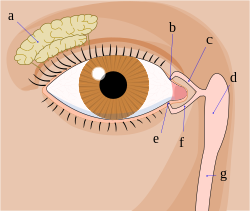
Back غدة دمعية Arabic Слёзная залоза Byelorussian Слъзна жлеза Bulgarian Glàndula lacrimal Catalan Tårekirtel Danish Tränendrüse German Larma glando Esperanto Glándula lagrimal Spanish Pisaranääre Estonian Malko-guruin Basque
| Lacrimal gland | |
|---|---|
 Lacrimal apparatus of the right eye. The lacrimal gland is to the upper left. The right side of the picture is towards the nose. | |
 Tear system. a = lacrimal gland b = superior lacrimal punctum c = superior lacrimal canal d = lacrimal sac e = inferior lacrimal punctum f = inferior lacrimal canal g = nasolacrimal canal | |
| Details | |
| Artery | lacrimal artery |
| Vein | superior ophthalmic vein |
| Nerve | lacrimal nerve |
| Identifiers | |
| Latin | glandula lacrimalis |
| TA98 | A15.2.07.057 |
| TA2 | 6846 |
| FMA | 59101 |
| Anatomical terminology | |
The lacrimal glands are paired exocrine glands, one for each eye, found in most terrestrial vertebrates and some marine mammals, that secrete the aqueous layer of the tear film.[1] In humans, they are situated in the upper lateral region of each orbit, in the lacrimal fossa of the orbit formed by the frontal bone.[2] Inflammation of the lacrimal glands is called dacryoadenitis. The lacrimal gland produces tears which are secreted by the lacrimal ducts, and flow over the ocular surface, and then into canals that connect to the lacrimal sac. From that sac, the tears drain through the lacrimal duct into the nose.
Anatomists divide the gland into two sections, a palpebral lobe, or portion, and an orbital lobe or portion.[3] The smaller palpebral lobe lies close to the eye, along the inner surface of the eyelid; if the upper eyelid is everted, the palpebral portion can be seen.
The orbital lobe of the gland, contains fine interlobular ducts that connect the orbital lobe and the palpebral lobe.[4] They unite to form three to five main secretory ducts, joining five to seven ducts in the palpebral portion before the secreted fluid may enter on the surface of the eye. Tears secreted collect in the fornix conjunctiva of the upper lid, and pass over the eye surface to the lacrimal puncta, small holes found at the inner corner of the eyelids. These pass the tears through the lacrimal canaliculi on to the lacrimal sac, in turn to the nasolacrimal duct, which dumps them out into the nose.[5]
Lacrimal glands are also present in other mammals, such as horses.
- ^ Schwab, Ivan R. (2012). Evolution's Witness : How Eyes Evolved. New York. p. 245. ISBN 9780195369748.
{{cite book}}: CS1 maint: location missing publisher (link) - ^ Moore, Keith (2018). Clinically oriented anatomy. Wolters Kluwer. pp. 897–900. ISBN 9781496347213.
- ^ Machiele, R (November 2018). "Anatomy Head and Neck". StatPearls [Internet]. PMID 30422509.
- ^ Machiele, R (November 2018). "Anatomy, Head and Neck, Eye Lacrimal Gland". StatPearls(Internet). PMID 30422509.
- ^ "eye, human."Encyclopædia Britannica. 2010. Encyclopædia Britannica 2010 Ultimate Reference Suite DVD 2010
© MMXXIII Rich X Search. We shall prevail. All rights reserved. Rich X Search